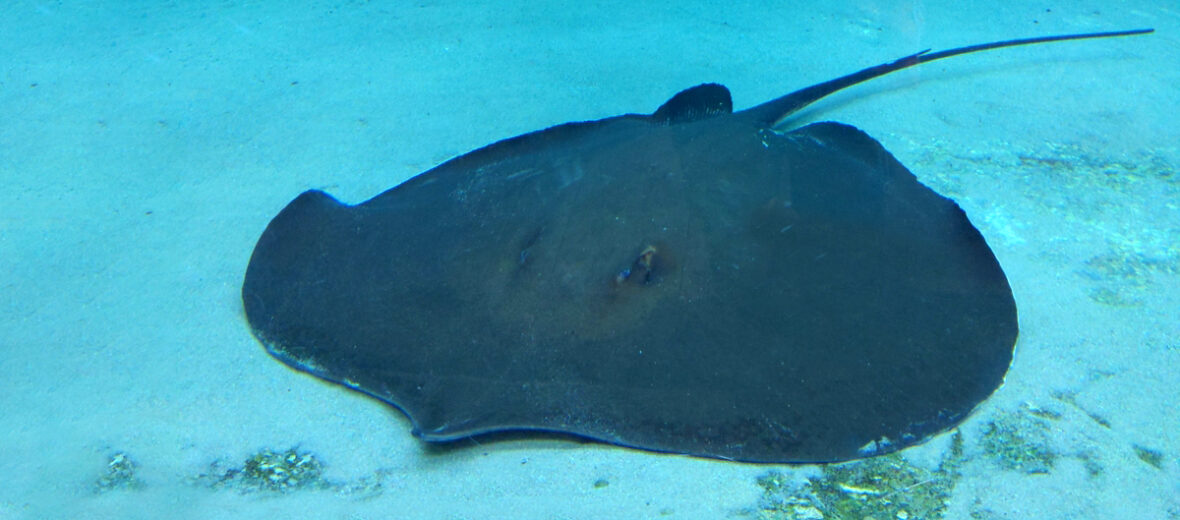
The giant freshwater stingray is the largest freshwater fish as well as the largest stingray in the world. They are found in larger estuaries and rivers of Southeast Asia and Borneo. Sadly, these amazing stingrays face the threats of habitat loss and destruction at the hands of residential and commercial developments, marine & freshwater aquaculture, and dams; logging; overfishing; pollution; and climate change, which can alter their habitat. The IUCN lists these creatures as Endangered. In Thailand they are listed as Critically Endangered. Their populations are also decreasing.
First the Stats…
Scientific name: Urogymnus polylepis
Weight: Up to 660+ lbs.
Length: Up to 7.2 feet, plus up to a 6 foot tail
Lifespan: Up to 10 years
Now on to the Facts!
1.) They are demersal, aka groundfish, that dwell at the bottom of rivers or estuaries.
2.) These stingrays prey on small fish, various shrimp, mollusks, and worms.
3.) The giant freshwater stingray was first described by Dutch ichthyologist Pieter Bleeker in 1852, in the journal Verhandelingen van het Bataviaasch Genootschap van Kunsten en Wetenschappen. Say that 5 times fast.
4.) However, in 1990 the giant freshwater stingray was later described again by Tyson Roberts and Supap Monkolprasit in an issue of the Japanese Journal of Ichthyology.
5.) Then in 2008, B. Mabel Manjaji-Matsumoto and Peter Last confirmed that T. polylepis and H. chaophraya refer to the same species, and since Bleeker’s name was published earlier, the scientific name of the giant freshwater stingray finally became Himantura polylepis.
But wait, there’s more on the giant freshwater stingray!
6.) These giants are also called giant stingray, giant freshwater whipray, or freshwater whipray.
7.) They are affected by various parasites such as tapeworms and more.
Did you know…?
Like other rays and sharks, these rays utilize their electroreceptive ampullae of Lorenzini to detect electromagnetic impulses from their prey items.
8.) The giant freshwater stingrays are viviparous (give live birth).
9.) Females nourish their developing embryos initially by yolk and later, after birth, by histotroph (uterine milk).
10.) They are not diadromous (migrate between fresh and salt water to complete their life cycle), like salmon do.
But wait, there’s more on the giant freshwater stingray!
11.) Females birth up to 4 pups that measure up to 12 inches across.
12.) Giant freshwater stingrays are not aggressive, but their sting is sheathed in a toxic mucus and is capable of piercing through bone.
Did you know…?
Populations in Thailand and Cambodia have been reduced by an estimated 95%!
13.) According to fishermen, these rays are notoriously challenging to catch. Hooked rays will often bury themselves under thick layers of mud or even drag the fishermen in their boats for long distances (sometimes even sinking boats), and hauling 1 up from the water’s bottom has proved very difficult as well.
14.) The size of caught rays has also been reduced. In 2006 the average size of a hauled in ray was only 15 lbs.
15.) In the 1990s, the Thai government initiated a captive breeding program at Chai Nat to bolster the population of this and other freshwater stingray species. However, that was short-lived, as by 1996 the program was put on hold.
Now a Short Giant Freshwater Stingray Video!
Be sure to share & comment below! Also, check out the Critter Science YouTube channel. Videos added regularly!
Want to suggest a critter for me to write about? Let me know here.
Some source material acquired from: Wikipedia & IUCN
Photo credit: iNaturalist



